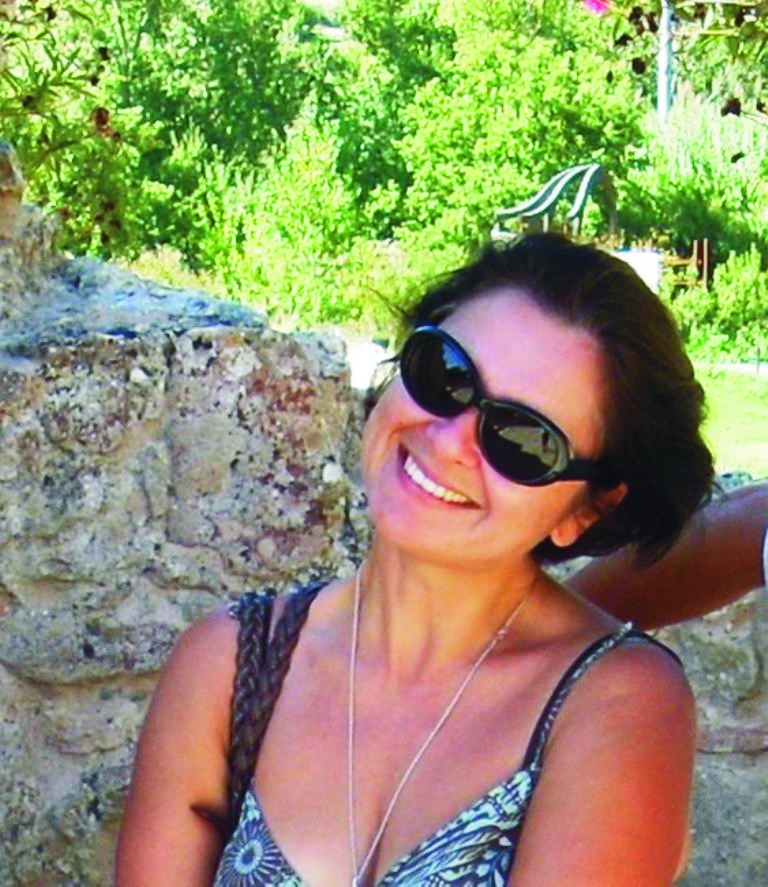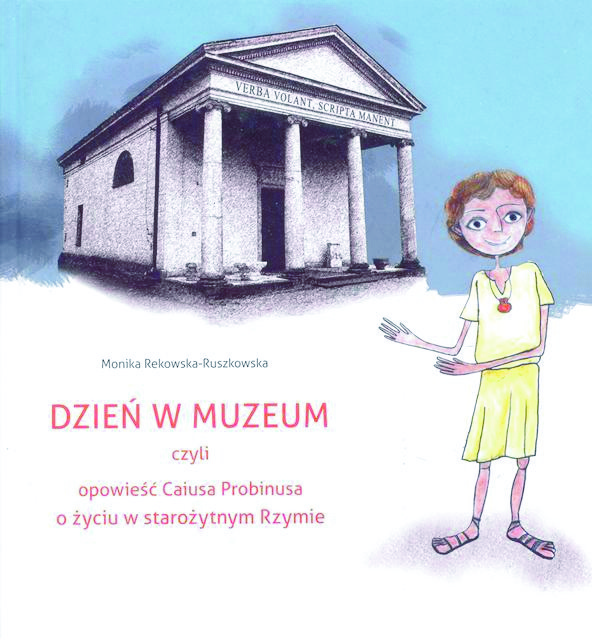Title of the work
Country of the First Edition
Country/countries of popularity
Original Language
First Edition Date
First Edition Details
Monika Rekowska-Ruszkowska, Dzień w muzeum, czyli opowieść Caiusa Probinusa o życiu w starożytnym Rzymie, ill. Joanna Żero. Gdynia: Novae Res, 2011, 121 pp.
ISBN
Genre
Novellas
Target Audience
Children
Cover
Courtesy of the publisher.
Author of the Entry:
Summary: Anna Ślezińska, University of Warsaw, annie_s@o2.pl
Analysis: Hanna Paulouskaya, University of Warsaw, hannapa@al.uw.edu.pl
Peer-reviewer of the Entry:
Katarzyna Marciniak, University of Warsaw, kamar@al.uw.edu.pl
Elżbieta Olechowska, University of Warsaw, elzbieta.olechowska@gmail.com

Photograph courtesy of the Author.
Monika Rekowska
, b. 1967
(Author)
Classical archaeologist, researcher at the University of Warsaw. She gives lectures on archaeology of Ancient Rome and Greece. Her special interests focus on the history of archaeology, especially on collecting the ancient art. She conducts also archaeological research and excavations in Sicily (Akrai, since 2011), before that in France (Limoges), Switzerland (Orbe), Germany (Haus Bürgel) and Libya (Ptolemais). She has been awarded Andrew Mellon Fellowship (MSH Paris, 2002), grants from the French Government (1995), the Italian Government (1999), and the Lanckoroński Foundation (2007, 2010). She popularizes classical themes among children and youth by lecturing in archaeology and ancient history at many Warsaw schools (since 2000). As a lecturer at Children’s University, Rekowska teaches classes that develop children’s interest in the ancient world (seminar Master and Student Per aspera ad astra, lecture on Do pots grow in the ground?). Her daughters are the source of her everyday inspiration: the 16-year-old Zuzia and 13-year-old Julka prove that their mama’s activities make sense.
Sources:
Bio based on the material kindly provided by the Author in 2013.
Bio prepared by Anna Ślezińska, University of Warsaw, annie_s@o2.pl
Summary
Based on: Katarzyna Marciniak, Elżbieta Olechowska, Joanna Kłos, Michał Kucharski (eds.), Polish Literature for Children & Young Adults Inspired by Classical Antiquity: A Catalogue, Faculty of “Artes Liberales”, Warsaw: University of Warsaw, 2013, 444 pp.
School children visit Park Arkadia in Nieborów. It is a historic, English style garden, with numerous themes recalling ancient architecture. A new guide, Monika, is a young archaeologist fascinated by the ancient world, especially Rome. When children reluctantly enter the park, she tries to convince them that a museum can be an interesting place, where the present meets the past. Monika starts to tell children about monuments situated in the park. Her story is very lively and children become quickly absorbed by it. Monika tells them about Roman funeral customs and shows them ancient urns. Zuzia, one of the school girls, hears a voice of a boy. When she closes her eyes, she can see a young Roman. His name is Caius Probinus, he is a 14-year-old Roman boy. Caius tells Zuzia about daily life in Rome, he describes his everyday activities and customs. His story portrays Ancient Rome: what did the typical household and school look like, what were the favorite games, what were women’s duties, why did everybody go to bathe in the thermae, and what food was served during the feasts. He also talks about Roman religion and beliefs. When Caius talks to Zuzia, Monika continues her story: about vases, sarcophagi and Roman gods. All the children are listening captivated. At the end of the visit, Zuzia admits that the history of Rome is fascinating and maybe she would become an archaeologist.
The book contains also some additional information about Roman calendar and monetary system. There is also a board for the game O tym, jak Rzym zakładano... [About Foundation of Rome...] and a final test for the willing young readers.
Analysis
The book naturally links Polish history and culture with Roman culture, as the whole story takes place in Helena Radziwiłłowa’s Arkadia*, a park established in 1778 in Nieborów near Łowicz, 80 km from Warsaw. Curiously, when Zuzia meets Caius Probinus and is surprised by his appearance and clothes, the boy knows that he is not “from [her] times” and “was born far from here and a very, very long time ago”** (p. 16). This implies that Zuzia was not the first modern-day person Caius met, and he acts as a sort of guide, similar to Monika.
The stories of Monika and Caius interweave and connect, and from time to time, Zuzia, in a daze, returns to the group that she has left behind. Monika, a young archaeologist and guide, is praised in the book, especially in comparison to the teacher, who is openly criticized (cf. pp. 8, 86). This may be a nod to the teenage readers who often rebel against their teachers and resent their excessively didactic attitude.
As the characters are 13 and 14 years old, we may suppose that the book is addressed to an audience of a similar age. We meet Caius near a funeral urn containing his ashes, which might be a strong and controversial start, but it seems that the author – an archaeologist – has no irrational fear of death and funeral objects, even if they involve children. The book finishes with the story of the death of Caius Probinus, so this topic acts as a logical end of the story (pp. 91–93). Although as the boy is somehow alive, his story does not overshadow Zuzia’s.
The book is written simply and in an attractive manner, easily catching the reader’s interest. The inclusion of games and tasks after each chapter makes it even more pleasant for the reader and creates an opportunity to review information about ancient Rome. A short bibliography listing books on Roman history addressed to children is also provided (p. 115).
* Accessed: September 16, 2022.
** “…ale ja nie jestem z twoich czasów. Urodziłem się daleko stąd i bardzo, bardzo dawno temu.”
Further Reading
Rekowska, Monika, "Architectural Decoration of the House of Leukaktios: Preliminary Remarks", in Jerzy Żelazowski, ed., Ptolemais In Cyrenaica. Studies in Memory of Tomasz Mikocki [Ptolemais I], Warsaw: Instytut Archeologii UW, 2012, 157–181.
Rekowska, Monika, "Der Besuch von General Michal Sokolnicki im Teutoburger Wald 1810", KölnJbVFrühGesch 30 (1997): 329–344.
Rekowska, Monika, "La collection d’antiquités d’Isabelle Czartoryska de Puławy", in Manuela Fano Santi, ed., Le collezioni di antichità nella cultura antiquaria europea. Incontro internazionale Varsavia–Nieborów 17–20 Giugno 1996, [RdA suppl. 21], Rome: G. Bretschneider, 1999, 142–153.
Rekowska, Monika, Le monde antique occidental dans les récits des voyageurs polonais du XVIIe au XIXe siecle, [“Światowit” Supplement Series A: vol. IX], Varsovie: Instytut Archeologii UW, 2002.
Rekowska, Monika, "Les monuments antiques de la France méridionale dans les récits des voyageurs polonais (XVIIe-XIXe siècle)", in Étienne Jollet, Claude Massu, eds., Les images du monument de la Renaissance à nos jours, Aix–en– Provence: Presses Universitaires de Provence, 2012, 31–48.
Rekowska, Monika, "Per Aspera ad Astra...Children at the University", in Roksana Chowaniec, Wiesław Więckowski, eds., Archaeological Heritage: Methods of Education and Popularization, [BAR Int. Series 2443], Oxford: Archaeopress, 2012, 145–151.
Rekowska, Monika, "Ptolemais in Early European Research and Topography of the City in Travellers’ Accounts", in Jerzy Żelazowski, ed., Ptolemais in Cyrenaica. Studies in Memory of Tomasz Mikocki [Ptolemais I], Warsaw: Instytut Archeologii UW, 2012, 1–34.
Rekowska–Ruszkowska, Monika, Polskie badania w Ptolemais, http: //www.archeolog.pl/pl33/teksty55/polskie_badania_w_ptolemais (accessed: February 14, 2013, no longer active).
Wykładowcy Uniwersytetu Dzieci, http://www.uniwersytetdzieci.pl/uds/ lecturers (accessed: February 15, 2013, no longer active).



